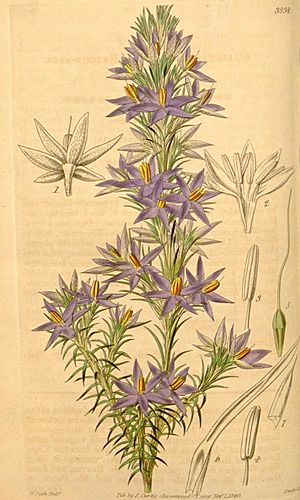Calectasia facts for kids
Quick facts for kids Tinsel lilies |
|
|---|---|
 |
|
| Calectasia cyanea 1841 illustration |
|
| Scientific classification |
|
| Kingdom: | Plantae |
| Clade: | Tracheophytes |
| Clade: | Angiosperms |
| Clade: | Monocots |
| Clade: | Commelinids |
| Order: | Arecales |
| Family: | Dasypogonaceae |
| Genus: | Calectasia R.Br |
| Synonyms | |
Tinsel lilies are a group of beautiful flowering plants. Their scientific name is Calectasia. They are found only in southern Australia. These plants are often called tinsel lilies because their flowers have a shiny, metallic look. They belong to a plant family called Dasypogonaceae.
Contents
What Do Tinsel Lilies Look Like?
Tinsel lilies are small, bushy plants. They usually grow up to about 50 centimeters (20 inches) tall. Their branches are stiff and stand upright. These branches are covered by old leaves and leaf parts.
The branches also have short, soft hairs. The leaves are shaped like spearheads. They have pointed ends and straight veins.
The Unique Flowers
The flowers of tinsel lilies grow one by one. They appear at the ends of short branches. Each flower has six petals. These petals are usually lilac-blue to purple. They form a short tube at the bottom. But mostly, they spread out like a star. This gives them a shiny, metallic look.
In the middle of the flower, there are six bright yellow or orange stamens. These stamens form a tube. A thin part called a style sticks out from the center of this tube.
Special Roots
Some types of tinsel lilies have special roots. These are called stilt roots. Plants with stilt roots can only grow new plants from seeds. Other types have tubers. Tubers are like underground storage parts. Plants with tubers can regrow from these parts.
If there is a fire, stilt-rooted species usually die. They need about five years without fire. This time allows them to flower and make new seeds.
How Tinsel Lilies Got Their Name
The first tinsel lily species was named Calectasia cyanea. This happened in 1810. It was named by a botanist named Robert Brown. He wrote about it in his book, Prodromus Florae Novae Hollandiae et Insulae Van Diemen.
The name Calectasia comes from ancient Greek words. Kalos means "beautiful." Ektasis means "development" or "spreading out." This name describes the beautiful, spreading blue petals of the flower.
Discovering More Species
For a long time, scientists thought there was only one species. Later, more types were found. In 2001, two scientists, Barrett and Dixon, studied the genus again. They added eight new species. Then, in 2015, four more species were added. Now, there are a total of 15 known species of tinsel lilies!
Where Tinsel Lilies Grow
Tinsel lilies grow in specific parts of Australia. You can find them in the southwest of Western Australia. They also grow in the areas where South Australia and Victoria meet.
One species, C. intermedia, is only found in South Australia and Victoria. All the other species grow only in Western Australia. These plants live in different places. Sometimes they are in wet, swampy areas. More often, they grow in low heathlands or woodlands. They can be found in sandy soil, or over laterite or granite rocks.
How Tinsel Lilies Interact with Nature
Scientists have found that all tinsel lily species have roots that help hold sand. Their flowers are also pollinated in a special way. This is called buzz pollination. Bees or other insects shake the flower to release pollen.
Plant Mimicry
It's possible that tinsel lilies look similar to another flower. This flower is called Thelymitra variegata. This might be an example of Dodsonian mimicry. This is when one plant looks like another to trick pollinators. Calectasia grandiflora and Thelymitra variegata often grow in the same areas.
Plant Parasites
Individual tinsel lily plants are often affected by a type of parasitic plant. This plant is like a dodder. It belongs to the genus Cassytha. These parasites attach to the tinsel lily and take nutrients from it.
Species of Tinsel Lilies
- Calectasia browneana Keighery, K.W.Dixon & R.L.Barrett
- Calectasia cyanea R.Br. - Star of Bethlehem
- Calectasia demarzii R.L.Barrett - Demarz's tinsel lily
- Calectasia elegans R.L.Barrett - elegant tinsel lily
- Calectasia gracilis Keighery
- Calectasia grandiflora L.Preiss - blue tinsel lily
- Calectasia hispida R.L.Barrett & K.W.Dixon
- Calectasia intermedia Sond. - blue tinsel lily (Victoria and South Australia)
- Calectasia jubilaea R.L.Barrett - jubilee tinsel lily
- Calectasia keigheryi R.L.Barrett & K.W.Dixon
- Calectasia narragara R.L.Barrett & K.W.Dixon
- Calectasia obtusa R.L.Barrett & K.W.Dixon
- Calectasia palustris R.L.Barrett & K.W.Dixon
- Calectasia pignattiana K.W.Dixon & R.L.Barrett
- Calectasia valida R.L.Barrett - robust tinsel lily
Images for kids
-
Illustration of Calectasia cyanea from Curtis's Botanical Magazine
See also
 In Spanish: Calectasia para niños
In Spanish: Calectasia para niños


